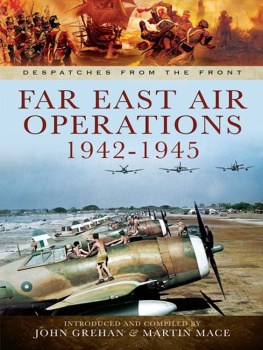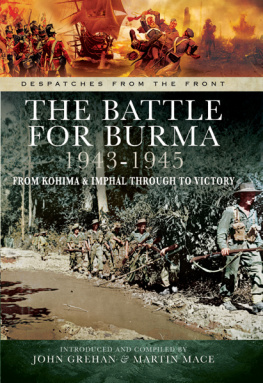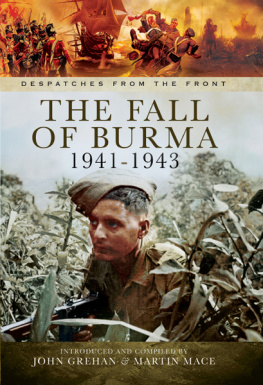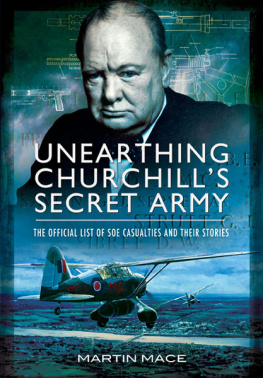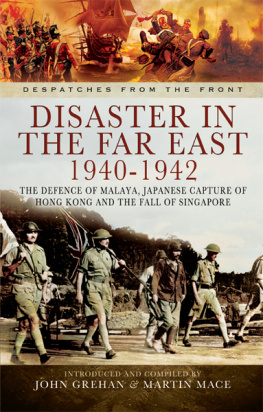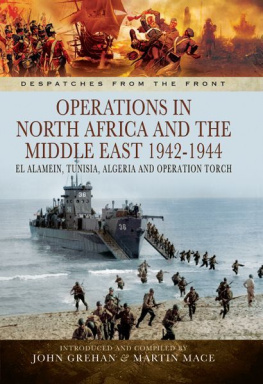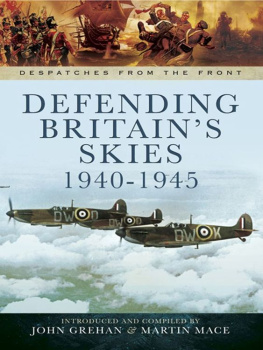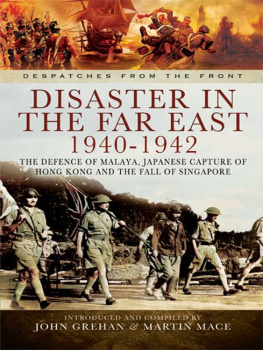
First published in Great Britain in 2014 by
Pen & Sword Military
an imprint of
Pen & Sword Books Ltd
47 Church Street
Barnsley
South Yorkshire
S70 2AS
Copyright Martin Mace and John Grehan, 2014
ISBN 978 1 78346 212 4
eISBN 9781473841741
The right of Martin Mace and John Grehan to be identified as Authors of
this Work has been asserted by them in accordance with the Copyright,
Designs and Patents Act 1988.
A CIP catalogue record for this book is available from the British Library.
All rights reserved. No part of this book may be reproduced or transmitted
in any form or by any means, electronic or mechanical including
photocopying, recording or by any information storage and retrieval
system, without permission from the Publisher in writing.
Printed and bound in England
By CPI Group (UK) Ltd, Croydon, CR0 4YY
Pen & Sword Books Ltd incorporates the Imprints of Pen & Sword Aviation, Pen & Sword Family History, Pen & Sword Maritime, Pen & Sword Military, Pen & Sword Discovery, Pen & Sword Politics, Pen & Sword Atlas, Pen & Sword Archaeology, Wharncliffe Local History, Wharncliffe True Crime, Wharncliffe Transport, Pen & Sword Select, Pen & Sword Military Classics, Leo Cooper, The Praetorian Press, Claymore Press, Remember When, Seaforth Publishing and Frontline Publishing.
For a complete list of Pen & Sword titles please contact:
PEN & SWORD BOOKS LIMITED
47 Church Street, Barnsley, South Yorkshire, S70 2AS, England
E-mail: enquiries@pen-and-sword.co.uk
Website: www.pen-and-sword.co.uk
CONTENTS
The Despatches
INTRODUCTION
Japans sudden and explosive entry into the Second World War completely changed the military situation in the Far East. The Japanese advance westwards was supported by strong air forces and, as the Japanese marched into Burma in late December, the battle for control of the skies over Rangoon began in earnest. This battle forms the basis of the early passages of the first despatch in this volume.
Air Vice-Marshal Stevenson commanded a small Allied Air Force (American Volunteer Group, Royal Air Force and Indian Air Force) consisting of just thirtyseven combat aircraft. There was only one battery of anti-aircraft guns for airfield defence other than Browning machine-guns. Apart from this weakness, the nature of the Burmese countryside, with its high jungle-covered mountains crossed with scarcely any roads, meant that the installation of radar and telephone communications was all but impossible. The defending aircraft therefore had no warning of any attack and this greatly hampered Stevensons ability to counter Japanese incursions.
Nevertheless, Stevenson called for reinforcements and began to build airfields to accommodate the expected arrivals. Using lots of local labour, a hard, dry paddy field could be converted into a landing strip for bombers or fighters in a day. Reinforcements began to arrive but not in the numbers that Stevenson had said were necessary for the defence of Burma. Even when squadrons of aircraft arrived, the lack of spares and workshop facilities meant that only a small percentage of aircraft were airworthy at any one time.
On 1 January 1942, the Japanese air force deployed for operations in Burma was reckoned by Stevenson to be around 150 strong. By 14 February both sides had received reinforcements. This brought Stevensons numbers up to fifty-three aircraft, those of the Japanese to 200. The latter increased still further and by the time Rangoon fell, on 7 March, the Japanese could count something in the region of 429 to 500 aircraft.
Despite this overwhelming disparity the Japanese fighters, of which there were three types deployed over Burma, were no match for either the Curtiss P-40s or the Hawker Hurricanes. Stevensons problem, though, was that without early warning, his fighters could be caught on the ground where they were defenceless. To quote Stevensons own words: Fighter for fighter we were superior and it was only when heavily outnumbered, and without warning and proper airfield facilities, that the enemy were able to get a decision. Their bombers were easy meat for our fighters if interception took place, while our bombers were satisfactory for their task, though light on range and much inferior to the enemy in bomb lift and numbers.
The first waves of Japanese attacks upon Rangoon were delivered by some sixty or seventy bombers with around thirty escorting fighters. A second series of attacks were undertaken between 23 and 29 January 1942, with the enemy despatching a total of around 218 aircraft, most of which were fighters, in a bid to eliminate Stevensons small force. In the air battles of those six days, the Allied fighter force claimed a total of fifty Japanese bombers and fighters destroyed.
So heavy were the Japanese losses, they were forced to revert to night bombing until, on 24 and 25 February, they made a final attempt to win air superiority over Rangoon. On those two days, they launched attacks with 166 bombers and fighters, but sustained the heavy loss of at least thirty-seven aircraft. On the second day, the 25th, the P-40s of the American Volunteer Group claimed no less than twenty-four aircraft shot down. This ended the Japanese efforts over Rangoon.
Such wastage had been inflicted on the enemy, Stevenson proudly boasted, that thereafter he never attempted to enter our warning zone round Rangoon until the city was captured and the air bases in his hands . We have come to think of the Battle of Britain as epitomising the David and Goliath struggle of the RAF against the Luftwaffe yet the Battle of Rangoon stands comparison. The Allied Air Force can undoubtedly be compared to The Few.
The latter part of Stevensons despatch deals with the air support for the British Army as it withdrew from Rangoon and then all of Burma. This includes the disaster at Magwe where, in two days of attacks, seventeen aircraft were destroyed or badly damaged where they sat on the ground.
Following the withdrawal from Burma, Allied forces in India were re-structured and on 16 November 1943, South East Asia Command was formed. Air Chief Marshal Peirse became Allied Air Commander-in-Chief, South East Asia.
Peirse had two main tasks upon taking up his new role. The first was to integrate the American, Indian and British air forces into a single, effective command. The second was to prepare for the re-invasion of Burma with the preparation of the air bases that would enable his command to provide support to the 14th Army when it began its drive eastwards. That support was to begin with a strategic bomber offensive to destroy enemy air forces and installations, selected rail, road and river communications, and depots and maintenance facilities.
Compared with the situation that Stevenson had found in 1942, Peirse had under his command forty-eight RAF and seventeen USAAF squadrons when he took over a figure to rise even further over succeeding months. Against this the Japanese had just 250 aircraft.
The odds had swung decisively in favour of the Allies, and perhaps the most significant element of this was when Supermarine Spitfires first flew over the Bay of Bengal. Aerial superiority, from that moment onwards, was assured. The enemy continued to send fighter sweeps over the Arakan, but, Peirse claimed, the Spitfires were able to inflict casualties upon them in the ratio of eight to one. The degree of superiority enjoyed by the Allied air force throughout the period covered by his despatch is indicated by the number of enemy sorties were sighted or plotted. These amounted to just 2,700, which was less than three per cent of the number of Allied sorties in that same time.
Next page
